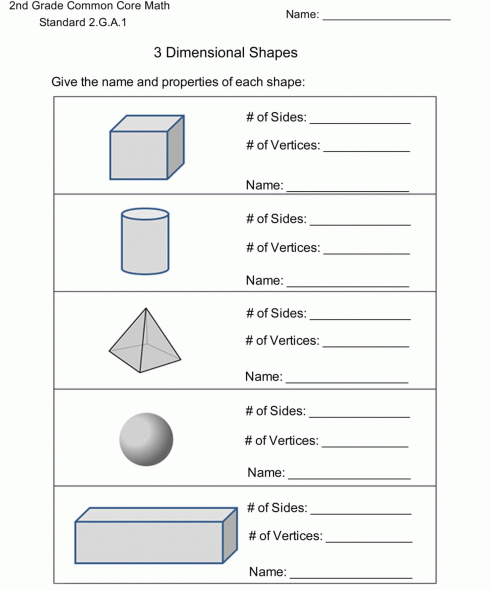3 Dimensional Shapes - Solids - Worksheet #1
Grade often used by:
1st Grade | 2nd Grade | 3rd Grade
Subject:
Math | Geometry |
Standards:
Common Core State Standard:
2.G.A.1
3-Dimensional Shapes: Learning the Basics
In this post, we’ll talk about what 3-dimensional shapes are, the different kinds of 3-dimensional shapes, and some of the basics of these shapes. We’ll also learn some important words about shapes that have three dimensions. By the time you finish reading this post, you should know a lot about 3-dimensional shapes and how they work.

What are 3-Dimensional Shapes?
There are many different kinds of shapes that have three dimensions. Spheres, cubes, cylinders, and cones are some of the most common shapes. Each type is different from the others because it has its own unique traits.
Spheres are round things that don’t have any flat sides. Their radius, the distance from the sphere’s center to its edge, tells us what they are.
Cubes are made up of six sides that are all the same length. The edge length of a cube is the length of each side. The amount of space inside a cube is called its “volume.”
Cylinders are two-sided objects with a round base and a straight line connecting the top and bottom faces. The distance between the cylinder’s top and bottom faces is its height, and the distance around its base is its circumference. When you multiply a cylinder’s height by its circumference, you get its volume.
The Basics of 3-Dimensional Shapes –
In geometry, a point is defined as a location. It has no size, and a dot represents it. A line is a straight path between two points. It has no thickness, and a line segment represents it. A face is a flat surface on a 3-dimensional shape.
Edges:
An edge is where two faces meet on a 3-dimensional shape. An edge is represented by a line segment where two faces meet.
Vertices:
A vertex is a point where three or more edges meet on a 3-dimensional shape. A vertex is represented by a dot where three or more edges meet.
Important Terms to Know:
A three-dimensional solid with flat faces and straight edges is known as a polyhedron. The Greek words “poly,” which means “many,” and “hedron,” which means “face,” are the origins of the word “polyhedron.” A polyhedron must have any number of faces, but there must be at least four. The pyramid, rectangular prism, and cube are the three most prevalent polyhedrons.
Based on how many facets they have, polyhedrons are categorized. The tetrahedron, which has four triangular faces, is the most basic polyhedron. There are five faces on a pentahedron, six faces on a hexahedron, and so on. Although they are uncommon, polyhedrons with more than 100 faces do exist.
Prism:
A prism is a polyhedron with two congruent (meaning “of the same size or shape”) polygons as its bases, which are connected by straight sides. In other words, a prism is a three-dimensional object with two parallel ends that are the same shape and size and are connected by straight sides. There are many different kinds of prisms, but the most common ones are rectangular and triangular.
Pyramid:
A pyramid is a polyhedral solid with a base that is either a triangle or a quadrilateral (a figure with four sides). The point where the pyramid’s sides meet is called the apex (or vertex). Pyramids come in many different shapes and sizes, just like prisms. The most common type of pyramid is the square pyramid because its base is usually a square or rectangle, which are easy shapes to see and draw.
Conclusion
In conclusion, 3-dimensional shapes are basic geometric structures with points, lines, faces, and edges. Based on their shapes, they are put into different groups. To understand more complicated math and physics ideas, you need to know the basics of 3-D shapes.


